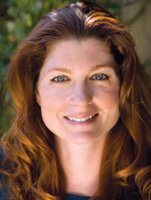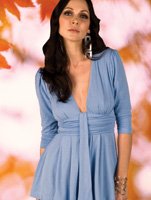Eco Style & Sensibility
Innovative fabrications and new technologies are hallmarks of EcoSkin’s initiative
As the former president and merchandiser of Tart Collections, EcoSkin designer Sandy Skinner is no stranger to the contemporary fashion market. Stocked in about 100 specialty stores—including Blonde, Belle Grey and Planet Blue—Los Angeles–based EcoSkin is a stylish, eco-friendly newcomer that made its debut with the Spring 2008 collection.
Comfort is key in the designs, without sacrificing style or environmental sensibilities, and wholesale prices range from $78 to $124. The Fall 2008 collection includes 28 styles hailed as “eco-chic, eco-smart and eco-sexy,” and the upcoming Holiday collection offers 16 styles.
“I still have my base fabric, which is a blend of bamboo, Tencel and Spandex,” says Skinner. “Unlike a lot of other eco brands on the market, EcoSkin is not primarily bamboo, though. I want to innovate and am always researching new eco technologies and fabrications.
“I have added hemp silk, which has been an amazing addition,” Skinner said. “It is 64 percent hemp and 36 percent silk. Hemp is one of the longest, strongest, most sustainable fibers on the market, and it is grown naturally without pesticides. It is a rotation crop, which is excellent for the environment. [The crop usually rotates from hemp to corn to soy and back to hemp.] Hemp is illegal to grow in the United States, so EcoSkin’s hemp fabric is supplied by Eco Source Inc.”
California Apparel News recently sat down with Skinner, who revealed her insider’s view of the eco-fashion market.
CAN: What prompted you to enter the eco-fashion market?SS: After working in the fashion business for 18 years, I wanted to find a way to promote a healthier ecosystem in my work life and not just my personal life. After educating myself about the earth crisis we are currently living in, I felt like I could make a difference and give women who cared about fashion an option for eco dressing. CAN: With the current influx of eco-friendly contemporary lines, how do you plan to stand out from the crowd?SS: I try not to focus on what the other lines are doing and stay driven on what my customer is reacting to. My line is really a broad collection that offers contemporary jersey dresses for day and night, structured wovens that can look very classy, and great basic pieces that focus on comfort and style. CAN: Has it been difficult to source the eco fabrics?SS: This has been the biggest challenge. For a start-up venture, you have to be careful to find fabrics that don’t have really high minimums and suppliers that are willing to partner with you to find new and exciting eco fabrics. There is still so much opportunity to find new, exciting and trend-driven eco fabrics at reasonable prices out in the marketplace. I definitely want to add some new fabrics. I am looking at hemp linen and a new soy-based woven. We are still in the development process on these fabrics right now. CAN: What precautions have you taken to ensure that your suppliers are using completely eco-friendly practices to produce these fabrics?SS: You have to make yourself important to your suppliers and know exactly what their procedures are for making the garments. You look for certifications and really do the research on where the fibers are coming from. If you keep your team small, it’s much easier to know exactly where each fabric is made and dyed. CAN: How has the line evolved since the launch? SS: I have learned a lot about what the customer is looking for in a new line. There has to be a great mix of fashion and comfort. I have found what styling is clicking with the customer and what fabrics she is comfortable wearing on a daily basis. Color has become even more important, and finding new fabrics is always the biggest challenge. CAN: What are the advantages and disadvantages of handling all of the production in California?SS: It is the only way, in my opinion, you can really start a contemporary eco line and be confident of fair-trade practices. I am in my factories every single week, and I see the product being sewn. The lead times are shorter, and with domestic production the factories are willing to work on smaller units to help keep the line special. CAN: What are the biggest challenges you face in producing this line?SS: The fabric minimums are really the hardest part. As a start-up, the line is small, and you need to find suppliers that are willing to work with you on small yardages and units to help get you started until your shipments really start getting substantial. CAN: What improvements do you anticipate and/or hope for in the eco apparel market?SS: The biggest change I hope for is finding new and innovative ways to dye and print the eco fabrics. New technology needs to be developed to help improve the quality currently available. All business could benefit from these improvements.
























